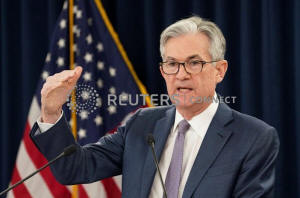Powell's white-collar world led to Fed pivot for
blue-collar jobs
 Send a link to a friend
Send a link to a friend
 [August 29, 2020] By
Howard Schneider [August 29, 2020] By
Howard Schneider
(Reuters) - Raised in a white-collar
Washington suburb, a product of prep schools, elite colleges and the 1%
world of private equity, Jerome Powell is an unlikely candidate to tilt
U.S. monetary policy toward the working class.
But just as former Federal Reserve chair Paul Volcker changed U.S.
central banking to fight inflation in service of the larger economy, so
Powell, the current Fed chair, has seized the moment to ease up on that
battle and, if a new Fed approach works as expected, register economic
gains for a broader set of Americans through more jobs and better wages.
If it sounds more humanist than "central bank," the underpinnings
nonetheless are deeply practical.
They rest on a decade's recognition that inflation is much less of a
threat than in Volcker's day, on changes in Powell's own perspective
from his first years as a Fed governor, and on research about how
persistent inequality can cause larger economic damage. In the
background, workers and labor groups scarred by the 2007 to 2009
financial crisis pressed for a different approach from the central bank.

"The Fed has come to its common senses," recognizing that higher
employment should be recognized as a good thing not treated as a risk,
said William Spriggs, a Howard University professor and chief economist
for the AFL-CIO. A frequent participant in Fed events, Spriggs made the
case for the central bank to let labor markets "run hot" so the benefits
of economic growth would be more broadly spread.
"It's clear. The days where the Fed Chair's primary role is to pull away
the punchbowl from the labor market just as things start going well
should be seen as decisively over," said L. Josh Bivens, research
director at the labor-focused Economic Policy Institute, referring to a
metaphor coined by a former Fed chair, William McChesney Martin, to
describe how the central bank acts to contain inflation. "It is a very
welcome acknowledgment about how much more room they have to probe the
absolute limits of full employment," Bivens said.
In acknowledging those arguments Powell echoed the language now more
frequently heard that racial, ethnic and other economic disparities are
more than just morally suspect. Indeed, as Powell said Thursday, they
"weigh on the whole economy."
"I WOULD HAVE BEEN SURPRISED"
The change comes at an opportune time. Thriving stock markets amid
massive, pandemic-related unemployment and a national debate about
racial justice have drawn attention to Fed policies as possible drivers
of inequality.
[to top of second column] |

U.S. Federal Reserve Chairman Jerome Powell speaks to reporters
after the Federal Reserve cut interest rates in an emergency move
designed to shield the world's largest economy from the impact of
the coronavirus, during a news conference in Washington, U.S., March
3, 2020. REUTERS/Kevin Lamarque/File Photo

The Democratic party platform for the November presidential election suggests,
for example, making the Fed take explicit account that the unemployment rate for
blacks is historically about twice that of whites. That divide began to narrow
as the unemployment rate dropped to historic lows last year, and the new Fed
framework now downplays the notion that unemployment could get too low.
If the framework change was driven by the low risk of inflation, it is also "an
incredibly pragmatic approach," said Adam Posen, president of the Peterson
Institute for International Economics. Under the Fed's prior framework, centered
around an almost ironclad trade-off between employment and inflation, "they were
leaving employment gains on the table," Posen said. "This is a move away from
fancy rules, abstract concepts, and it is absolutely justified."
It was no spur-of-the-moment shift.
Since he was appointed to the Fed board in 2012, in fact, Powell has steadily
moved from centrist Republican concerns about government debt and inflation to
embrace the view that there was more "slack" in the economy - the Fed's
euphemism for people not working - than generally recognized.
A graduate of elite schools - Georgetown Prep, Princeton University and
Georgetown University Law School - Powell was a well-known figure in Washington
for his prior work in the government, at the Carlyle Group private equity firm
and at the Bipartisan Policy Center think tank. He made clear early in his
tenure that he would challenge some of the standard thinking at the central bank
- bringing a lawyer's critical thought, a deal maker's practicality, and a
non-economist's skepticism into the room.
In a speech two years ago at the Fed's Jackson Hole summit, he laid out why he
felt some of the core concepts relied on by the economists at the central bank
weren't much help in setting policy. It was a step toward the new framework
announced on Thursday, at this year's virtual version of the same annual
symposium.
His partner in devising it: Vice Chair Richard Clarida, a former managing
director of the global bond giant PIMCO.
"If you had told me who would have made the biggest, let's just call it
progressive step, in changing monetary policy, and told me the background of
these two, I would have been surprised," Bivens said.
(Reporting by Howard Schneider; Editing by Dan Burns and Leslie Adler)
[© 2020 Thomson Reuters. All rights
reserved.] Copyright 2020 Reuters. All rights reserved. This material may not be published,
broadcast, rewritten or redistributed.
Thompson Reuters is solely responsible for this content. |